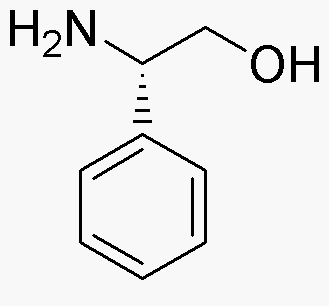L-Phenylglycinol is widely utilized in research focused on:
- Pharmaceutical Development: It serves as a key intermediate in the synthesis of various pharmaceuticals, particularly in the production of drugs targeting neurological disorders.
- Chiral Auxiliary in Organic Synthesis: This compound is used as a chiral auxiliary in asymmetric synthesis, helping chemists create specific enantiomers that are crucial for drug efficacy.
- Flavor and Fragrance Industry: L-Phenylglycinol is employed in the formulation of flavors and fragrances, enhancing the sensory profiles of food products and perfumes.
- Biochemical Research: It is utilized in studies involving amino acid metabolism and protein synthesis, providing insights into various biological processes.
- Cosmetic Formulations: The compound is incorporated into cosmetic products for its moisturizing properties, improving skin hydration and texture.
General Information
Properties
Safety and Regulations
Applications
L-Phenylglycinol is widely utilized in research focused on:
- Pharmaceutical Development: It serves as a key intermediate in the synthesis of various pharmaceuticals, particularly in the production of drugs targeting neurological disorders.
- Chiral Auxiliary in Organic Synthesis: This compound is used as a chiral auxiliary in asymmetric synthesis, helping chemists create specific enantiomers that are crucial for drug efficacy.
- Flavor and Fragrance Industry: L-Phenylglycinol is employed in the formulation of flavors and fragrances, enhancing the sensory profiles of food products and perfumes.
- Biochemical Research: It is utilized in studies involving amino acid metabolism and protein synthesis, providing insights into various biological processes.
- Cosmetic Formulations: The compound is incorporated into cosmetic products for its moisturizing properties, improving skin hydration and texture.
Documents
Safety Data Sheets (SDS)
The SDS provides comprehensive safety information on handling, storage, and disposal of the product.
Product Specification (PS)
The PS provides a comprehensive breakdown of the product’s properties, including chemical composition, physical state, purity, and storage requirements. It also details acceptable quality ranges and the product's intended applications.
Certificates of Analysis (COA)
Search for Certificates of Analysis (COA) by entering the products Lot Number. Lot and Batch Numbers can be found on a product’s label following the words ‘Lot’ or ‘Batch’.
*Catalog Number
*Lot Number
Certificates Of Origin (COO)
This COO confirms the country where the product was manufactured, and also details the materials and components used in it and whether it is derived from natural, synthetic, or other specific sources. This certificate may be required for customs, trade, and regulatory compliance.
*Catalog Number
*Lot Number
Safety Data Sheets (SDS)
The SDS provides comprehensive safety information on handling, storage, and disposal of the product.
DownloadProduct Specification (PS)
The PS provides a comprehensive breakdown of the product’s properties, including chemical composition, physical state, purity, and storage requirements. It also details acceptable quality ranges and the product's intended applications.
DownloadCertificates of Analysis (COA)
Search for Certificates of Analysis (COA) by entering the products Lot Number. Lot and Batch Numbers can be found on a product’s label following the words ‘Lot’ or ‘Batch’.
*Catalog Number
*Lot Number
Certificates Of Origin (COO)
This COO confirms the country where the product was manufactured, and also details the materials and components used in it and whether it is derived from natural, synthetic, or other specific sources. This certificate may be required for customs, trade, and regulatory compliance.


